Jun
24
2008
There’s no question there was some serious fall out from a series of three shark attack within one month in ZIhuatanejo, Mexico (two attacks were fatal). Theories abounded, locals went on a shark killing spree, and media flocked in. Everything from La Nina to Mexican drug runners were blamed. The area which relies on tourism has most likely taken and will continue to take a big hit. LA Times wrote an article that summarizes the incident and responses well.
Outside Magazine Blog published a post that suggests that some locals in the area and “critics” have called into question whether the surfers are to blame noting a certain “reckless selfishness” that surfers display by surfing in areas that might have sharks. Well, I couldn’t find any other reference in any media source that cited locals stating this. As to “critics,” who exactly are these critics? Aside from factual reliability of this statement, it ignores the fact that the last shark attack in the area (in Nayarit, a state 200 miles away!) was in 1972!!! That ranks it as one of the safest surf areas in the world for shark attacks. So to suggest that surfers are knowingly paddling out into shark ridden areas is absurd, as of the attack in April it had been 35 years since there had been an attack within 200 miles!
Shark attacks are nothing new, in fact it’s what sharks do and what they will always do. They have to eat, occasionally they mistake one of us for prey. It’s unfortunate and has tragic results, but also extremely rare (there’s an average of 3.8 fatalities annual worldwide and only 1 in 2007). It shouldn’t keep people from the water although when attacks do happen in certain areas, surfers and swimmers should exhibit caution. Surfline lists a few precautions:
Here are a few things you can do that will reduce the likelihood of an encounter. Don’t surf those areas that are utilized by grunion during their spawns – larger predatory fish will frequent these areas. Don’t surf after sunset and before dawn – sharks are known to migrate towards land at night. Don’t surf a beach where a recent shark encounter or attack has occurred – this one is obvious, the shark could still be in the area. Don’t surf near pinniped haul-out sites – they are a primary prey species for adult white sharks.
Jun
16
2008

The Sun reports that the recent shark attacks in Mexico may be due to sharks in the area acquiring a taste for humans by feeding on bodies dumped in the ocean by the Mexican mob. The Sun reports that local authorities are investigating this theory. Really? The story doesn’t validate whether the Mexican mob has in fact dumped “hundreds of bodies” in the ocean or whether it’s been witnessed that sharks either feed on these bodies or that they have been found with shark bites in them. If there were in fact hundreds of bodies dumped, then you would think that a few would wash a shore or be found by fisherman. On my trip to Zihuatenajo in April weeks ago, I was surprised by the presence of armed Mexican marines in the tiny surf town of Troncones. There were also roadblocks with heavily armed Mexican solders up and down the highway suggesting some issues with the drug trade. But I never heard anything about bodies being dumped in the ocean. You’d think a publication like the Sun would want to check their facts and get real source not a couple of guys in a bar.
Outside magazine published a blog post, suggesting maybe surfers were to blame. In spite of all the media coverage and the hype, the risk of death from a shark attack is pretty much insignificant. Worldwide there’s an average of 2.7/year for all surfers, swimmers, and beachgoers. Pretty slim considering how people are out there in the water.
Jun
11
2008

Shark Shield, the once touted solution to our shark fears, leaves us further in doubt about our shark-resistant future. I posted a while back about a test of theirs that went as wrong as it could go when a female white shark swallowed the device whole! (post) In principle the Shark Shield is simple. Sharks use a very sensitive organ in their snout to detect minute electrical fields generated by their prey’s muscle movements conducted through the water (or in our case, the surfer’s muscle movements). Shark Shield emits an electrical field (conducted through the salt water) that would in theory startle and repel sharks. Reasonable thinking. [more after jump and a video on the device]
Continue Reading »
Jun
04
2008
OK, I promise I’ll get back to surf travel related posts, just one more shark post…
If you wondering whether all the shark-attack hysteria has had an effect on your psychology, it probably has. Beach goers have called in 50-70 shark sightings to lifeguards in San Diego since the April fatal attack on a swimmer in Solano Beach. Compare that with 1-2 reported sightings in the previous 15 years!!! A group of surfers reported seeing a shark last week by 11th street, but lifeguards could not confirm that there was a shark in the area.
Scientists are speculating [link and video] that the recent surge in shark attacks in Mexico are due to La Nina, a weather patterns that results in cooler water in the Pacific. La Nina also causes the boundary of cooler/warmer water to be closer to shore which may be why so many more sharks are in and around the beaches of Zihuatanejo.
Local official in Zihuatanejo have started a study expected to last a year where they will be tagging hundreds of sharks and tracking the sharks via electronic radio device [Reuters link]. Biologists running the study will also also local fisherman to report back on any sightings, catches, or encounters with tagged sharks. Smaller sharks will be tagged with telemetric tags that reports location via radio emitting tag. This is a welcome change in their original response to the fatal shark attack in April where local authorities hunted and killed sharks in the area.
It’s good to see Mexico engaging in a thoughtful and well-design study that will provide useful data for the area and for science in general. Their initial response of hunting and killing sharks was short-sighted and ultimately back-fired as there were two additional attacks after the hunt.

May
29
2008
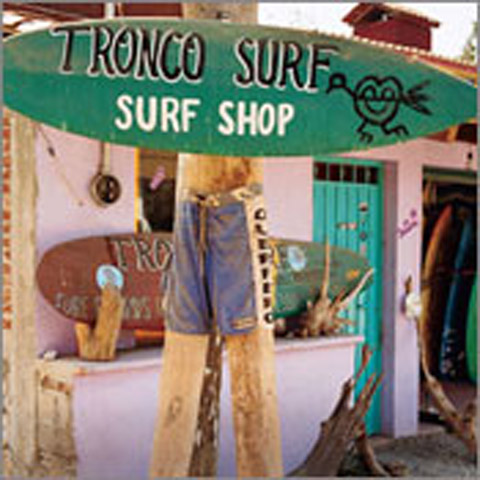
The news coverage of the shark attacks in Zihuatanejo and Troncones, Mexico has been out of hand with pretty much every major news outlet and TV outlet adding to the feeding frenzy! Concierge did a good summary of the blog and news coverage here. It’s especially ironic considering how much a sleepy surf village Troncones is. One thing for sure, the line-ups in Guerrero are going to be empty now. So while scientists and reporter can debate whether global warming is to blame for the increasing global incidence in shark attacks, the fact is you’re more likely to die from a “collapsing sand hole incident” (yeah, I don’t really know what one is either) than from a shark attack (shark attack risk of death). So, if you want to score empty waves, now may actually be the best time to head down to Guerrero, Mexico (check out our guide to surfing the area of Guerrero and Michoacan). Your biggest struggles on a surf trip may more likely be from dealing with the logistics like getting scammed renting a car than with anything in the line-up. Regardless, don’t let it keep you out of the water and from exploring. Go surf!
May
28
2008
The recent shark attacks (and deaths) on surfers in the Zihuatanejo area of Mexico (state of Guerrero) has alarmed everyone in the area and even brought in the Mexican Marines and Navy to patrol and spot for sharks. So far, the Navy has reported not spotting any large sharks in the area; but locals remained concerned.
After the first shark attack in April, officials responded by hunting sharks in the area. There was a large backlash from environmentalist, tourist, and surfers. Unfortunately, the approach did not work as there were two additional attacks in the same area (one fatal). [See related posts below for more info] Local officials now are working hard at determining the species involved by catching and releasing them and trying to spot sharks instead of haphazardly hunting and killing them.
The attacks and recent press coverage is sure to dissuade travelers and surfers considering going to the area. Bruce Grimes, the American who was attacked on Sunday and lost his thumb to the attack, owns a surfshop in the Zihuatanejo area and is concerned about the effect of the attacks on business. In spite of his injuries, he’s planning a return to the water after his recovery.
“I’ll go right back. Yeah, I’m that stupid,” Grimes said, examining his bandaged arm outside the hospital where he just had his daily cleaning. “I’ll go right back out as soon as I’m able to.” [AP Press article]
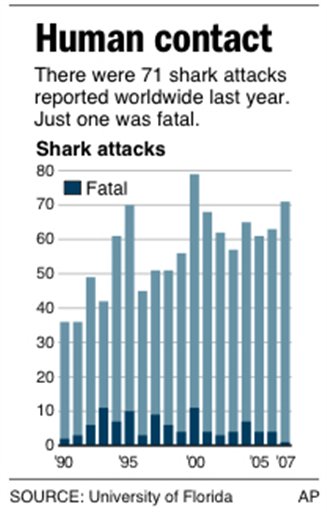
May
27
2008
So this shark thing is getting a little out of hand, and I promise some non-shark related posts after this one. The authorities in Mexico are taking the shark attacks very seriously (especially since the area is so dependent on tourism and surfer tourism). They’ve brought in the marines and the navy (the marines oddly had a strong presence when I was down there a month ago before the attacks in Troncones). From Reuters [link].
The response seems much more tempered and reasonable than their last response after the attack in April which was to go on a shark killing spree. And yes, the title suggesting a Jaws IV location in Zihuatanejo was a joke.
Reuters: The Mexican Navy searched for sharks in the ocean near Pacific surfing beaches on Monday, after two bathers were killed and another maimed in a rare spate of shark attacks.
Three boats and a helicopter patrolled the sea while Navy and rescue officials scanned the horizon with binoculars from popular beaches around the southwestern Mexican resort of Ixtapa-Zihuatanejo. They warned surfers not to go far out.
“We’ve been monitoring the beaches; we’ve done reconnaissance flights,” Rear Adm. Arturo Bernal said, adding that no big shark had been detected yet in the area.
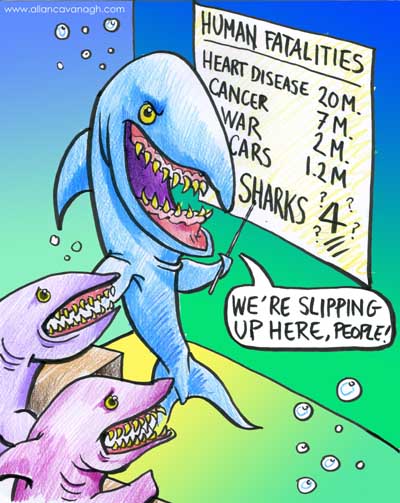
May
25
2008
A shark injured a 49-year-old American surfer Saturday, May 24, at Playa Linda in Zihuatanejo, Mexico. The attack is the third in one month in the area with a fatal attack on a Mexican surfer occurring a day earlier 20 minutes north near the beach resort area of Troncones. Adrian Ruiz, a surfer from San Francisco, was killed in an attack in April in Troncones. Authorities have not closed beaches in Zihuatanejo, but people were being advised against swimming.
Bruce Grimes, 49 from Florida, suffered minor injuries in the attack and managed to get to the hospital on his own.
“I felt something brush past me three times, scraping my skin like sandpaper. Then I saw a three-meter (10-foot) shark attacking my right arm,” Bruce Grimes told reporters after leaving the hospital Saturday.
Official blame the new influx of shark in the area on climate change.
“We brought shark specialists to the area and the first thing they said was that [sharks] could be because of cold water currents caused by climate change,” said Guerrero state’s environmental minister, Sabas de la Rosa. [Link to story]
Troncones, Mexico is officially the worst place to surf right now. Unfortunately, after the first attack in April there, local authorities responded by baiting and killing 12 sharks. It’s interesting that they blame climate change for sharp increase in shark attacks (Mexico hasn’t had a fatal shark attack in 30 years before the attack in April). I wrote a post a little while back on scientists linking increased shark attacks on global warming. I’m sure there will be a million theories on it, but it a troubling trend with three fatal attacks in one month.
The shark hunt by local authorities after the last hunt becomes particularly questionable after a recent report by the International Union for the Conservation of Nature that more than half of the world’s shark are under threat of extinction.
May
24
2008
Another surfers was killed in a shark attack in Mexico at Pantla Beach, 6 miles from Troncones where Adrian Ruiz was killed by a shark a month ago. Pantla Beach is 20 minutes North of Ixtapa. The attack on Ruiz was the first fatal shark attack in Mexico in 30 years.
Osvaldo Mata Valdovinos, 21, was attacked on Friday while surfing off Pantla beach west of Ixtapa and Zihuatenajo. The shark bit off his left hand and broke one of his legs. [Associated Press Link]
Mexican Authorities responded to the last attack a month ago by baiting and killing sharks in the area. Environmentalist deplored the tactics [link].
The map below shows where Pantla Beach is located in relation to Troncones and Ixtapa. Many of the news sources incorrectly reported the attack near Acapulco. Pantla Beach is approximately 100 miles west of Acapulco.
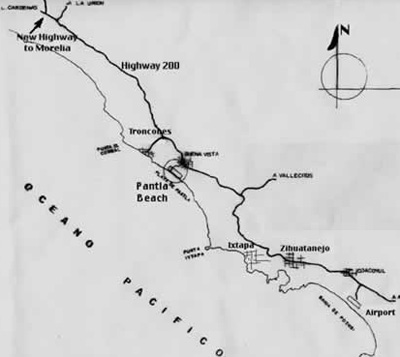
May
13
2008

With all the recent shark attacks and hysteria surrounding them in the media, I decided to look up some statistics on shark attacks and death. The International Shark Attack File has tons of good information and statistics on shark attacks. This page compares the risk of death of shark attacks to everything from an alligator attacks to a “collapsing sand hole incident.” And according to their graph below what you’ve heard is true, you’re far more likely to die from a lightning strike or fireworks than from a shark attack (let alone heart disease, car accident, or multiple drug-resistant bacteria). So buckle up, wear a helmet, watch out for collapsing sand hole, and surf your brains out.
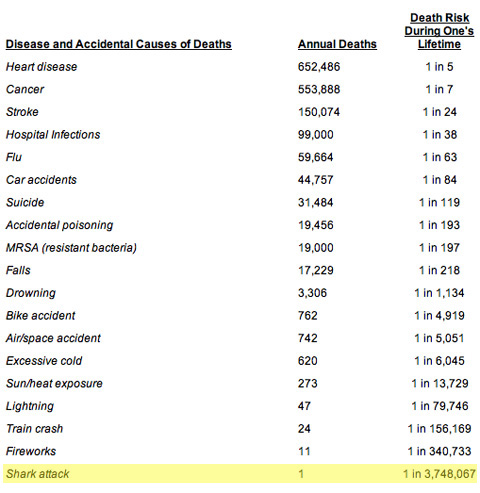
Check our post on annual number of shark attack and deaths (here).
See Other Amazing Posts:
The Most Amazing Photos You’ll Ever See of Waves
Diver Fights and Kills 12 ft. Tiger Shark (Photos)
1000 Lb Stingray and a Fish with a Transparent Head
More Plastic in the Pacific than Plankton
Incredible HD Footage of Surfer in the Barrel








